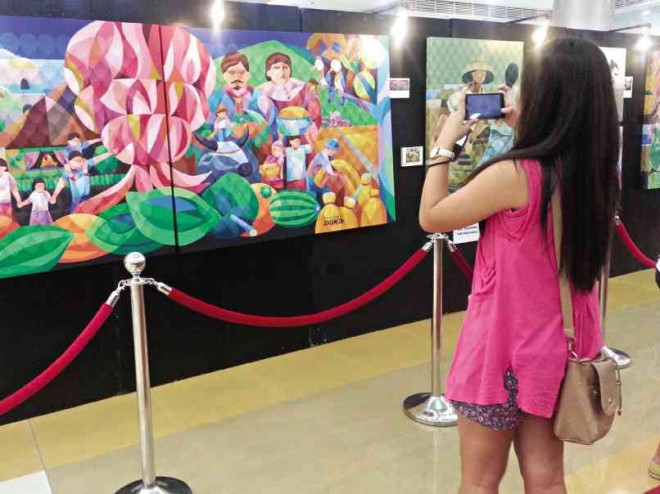Quezon relives glory of Lucban painter

AN EXHIBIT dubbed “Saludo kay Zalameda: A Tribute to Oscar de Zalameda’s Art” at SM City Lucena in Lucena City. De Zalameda, internationally known for his artworks, hailed from Lucban town, Quezon province. DELFIN T. MALLARI JR.
The senior student knows Fernando Amorsolo and Juan Luna, for she has learned about the lives of the great Filipino masters in her school in Quezon province. But Oscar de Zalameda?
“This is the first time I heard of his name,” Carmel Rose Rolloque, a student of Quezon Science High School, told the Inquirer while viewing the exhibit of paintings of the known Filipino artist.
Her teacher, Nepheline Khaye Karen Perez, 25, also confessed to her limited knowledge of De Zalameda. “It’s good that there’s this painting exhibit. At least, the present generation will have a chance to know him and his paintings,” she said.
De Zalameda, a native of Lucban town in Quezon, was one of the Filipino masters in the ’50s up to the ’70s. But several decades after he retired from the art scene and his works still greatly valued by collectors, the name of the late artist no longer rings a bell to the present generation, ironically, even to fellow Quezonians.
To resurrect De Zalameda’s lost glory, the provincial tourism office along with an equally known Lucban native, painter Eric Lodriga Dator, and SM Lucena, held an art exhibit on Sept. 24-26 at the atrium of the mall in Lucena City.
Article continues after this advertisementDubbed “Saludo kay Zalameda: A Tribute to Oscar de Zalameda’s Art,” the show coincided with the artist’s 84th birth anniversary.
Article continues after this advertisementIn 2006, then President Gloria Macacapagal-Arroyo bestowed on De Zalameda the Presidential Medal of Merit for his cultural contribution to the country.
De Zalameda was born on Sept. 24, 1930, in Lucban at the foot of Mt. Banahaw. He died on July 10 from a lingering illness.
Considered the favorite artist of former first lady Imelda Marcos, De Zalameda graduated from high school in 1949 at Tayabas High School (now Quezon National High School) in Lucena. He finished his fine arts degree from University of Santo Tomas and soon became part of the elite art league in the United States and Europe.
De Zalameda was among the first recipients of the annual Quezon Medalya ng Karangalan in the early 1970s.
‘Cool’ paintings
Rolloque said her school introduced its students to only historically famous Filipino painters, like Amorsolo and Luna, but not to De Zalameda and other renowned local artists. She urged educators to “first introduce the locals before the other artists from outside of Quezon.”
During her first encounter with De Zalameda, Rolloque readily admired his paintings as real-life depiction of the Filipinos’ daily lives.
“He is really good. His paintings are cool. The viewer can immediately feel the happiness behind his paintings,” she said, pointing to the rows of Dator’s replicated art pieces next to the canvass.
Originals, replicas
Alberto Bay Jr., Quezon tourism officer, said “the immeasurable contribution of a Quezonian to the country’s art scene should not be forgotten.”
He said his office tried to borrow some of De Zalameda’s paintings from several collectors for the exhibit but it was able to secure only two from Lucban.
For the exhibit, Dator said he gathered all of De Zalameda’s works from the Internet and painted replicas on his patented kiping-textured canvases. Some of those replicas were bought at prices ranging from P50,000 to several hundred thousand pesos, he said.
“It is an honor for me to show my own paintings of his (De Zalameda) works. He was a fulfilled artist. His painting is worth millions of pesos,” said Dator, who is now reaping the fruits of his own works displayed in several exhibits in the United States.
He said De Zalameda served as his inspiration when he decided to follow his footsteps in the art scene.
In his poster, Dator was described as an experimental folk artist who chooses tempera and acrylic as medium and cutout boards in the shapes of kiping (rice wafers) for canvas.
Former Sen. Robert Jaworski, who was special guest at the exhibit opening and a good friend of De Zalameda’s, described the late painter as an exemplary artist because he was a good person.
“If he is a bad person, he could not paint beautifully. He is something else. His colors express and give more meaning to life,” Jaworski, the Filipino basketball icon said in his tribute to De Zalameda.